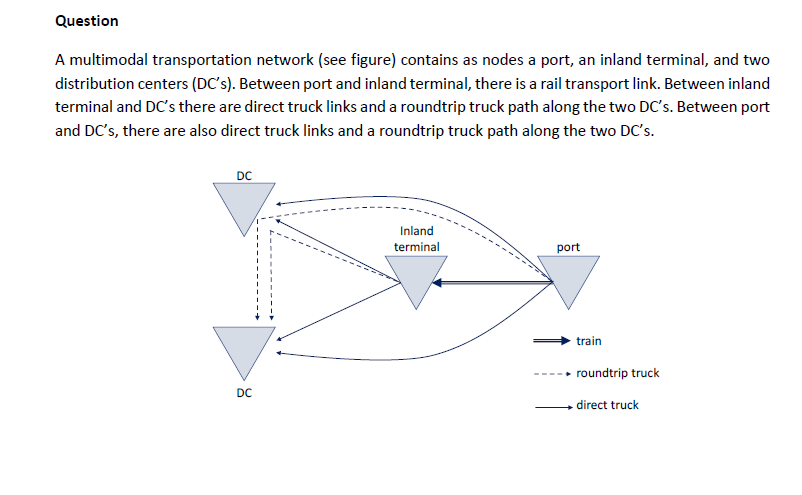(Solved): The rail transport service is either organized daily or every two days. A train may hold as many con ...
The rail transport service is either organized daily or every two days. A train may hold as many containers as required. A truck carries a single container, and a container holds 24 pallets of goods. Truck transport either from the port or the inland terminal can be organized in two ways: (i) direct delivery of full truckload to each DC; (ii) roundtrip along the two DC’s where the truck delivers an equal number of pallets to both DC’s, i.e., 12 pallets each. Daily demand for each DC equals 12 pallets, which are gradually consumed. The transportation of a single container by train costs 100 euro, while the transportation of two containers by train costs 180 euro. Handling costs at the inland terminal costs 20 euro per container. The dispatch of a truck from the inland terminal costs 100 euro, while for each stop at a DC, an additional 20 euro is charged. The dispatch of a truck from the port costs 200 euro; such a truck will travel directly to a DC or both DC’s, in case of a roundtrip. For the truck dispatched from the port, the same costs for each stop at a DC are charged. There are no charges for containers stacked at the terminals, while weekly inventory costs for a pallet at the DC equal 1 euro. Costs for handling containers at the port, in-transit inventory, opening containers, handling pallets, moving empty containers, return trips for trucks and trains, etc. need not be considered. When containers are transported by rail, the containers are handled at the inland terminal and put on truck for direct delivery to DC’s or roundtrip along DC’s. When containers are transported by truck only, then no handling occurs at the inland terminal. a) Compute the overall inventory and transportation costs, to the extent applicable, for the case of daily rail trips combined with truck transport. This involves two different cases with either direct truck transport to the DC’s or roundtrips by truck along the two DC’s. Compare the two cases, i.e., direct and roundtrip truck transport combined with rail, with respect to inventory and transportation costs. b) Argue how the overall inventory and transportation costs change when rail trips are not deployed daily but every two days. Make the comparison for the two cases of direct and roundtrip truck transport, combined with rail. c) Compare the two cases based on performance criteria other than costs, for example throughput time, reliability, and service frequency. (max 60 words). Question A multimodal transportation network (see figure) contains as nodes a port, an inland terminal, and two distribution centers (DC's). Between port and inland terminal, there is a rail transport link. Between inland terminal and DC's there are direct truck links and a roundtrip truck path along the two DC's. Between port and DC 's, there are also direct truck links and a roundtrip truck path along the two DC 's. ck
